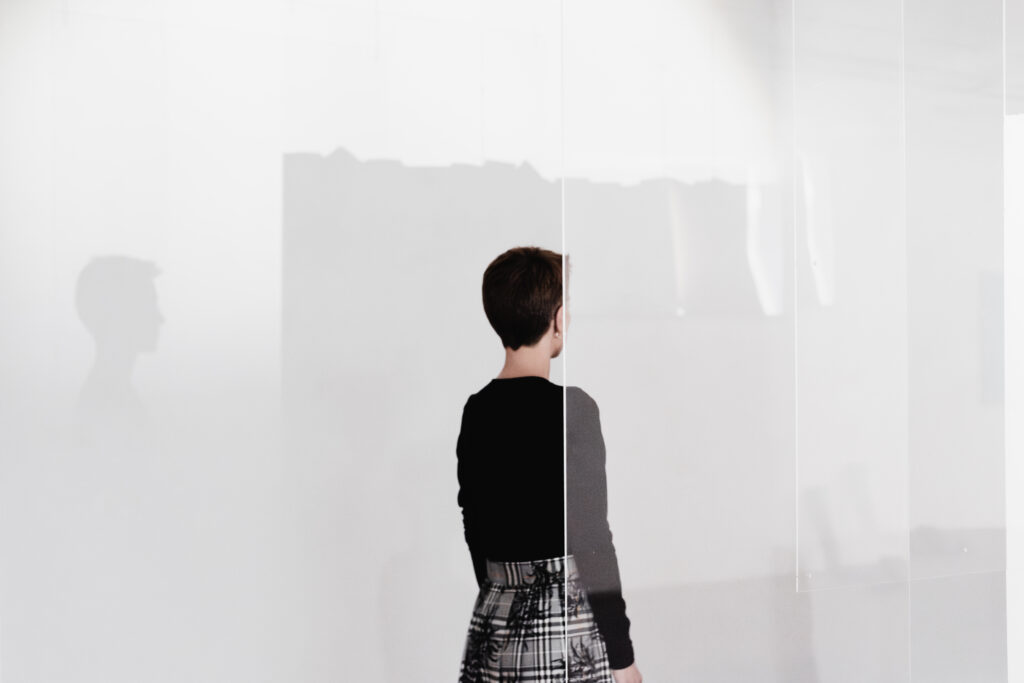ANNO
2024
TECNICA
plexiglas, smalto e proiezione
DIMENSIONI
variabili

Con le cinque superfici in plexiglas, Quida divide lo spazio. Di queste, tre soltanto vengono oscurate per metà con un pigmento bianco, lasciando il resto nell’assoluta trasparenza. Un fascio di luce sviluppato da un proiettore posizionato di fronte all’installazione illumina l’intera superficie, ma solo la parte lasciata in trasparenza si farà attraversare, riproducendo così le ombre al passaggio degli spettatori. Due parti, una diurna e una notturna, una sola materia formata da due principi contrapposti: la luce infinita e l’oscurità. L’ineffabile e l’inesprimibile in Immagine e assenza trovano la loro raffigurazione, sono rappresentati nell’antitesi giorno/notte. Luce come mezzo espressivo e narrativo, elemento sensibile in grado di attraversare la materia, generatore di presenza e svuotamento, icona del visibile che rimanda a un’alterità. Una considerazione sul corpo e sullo spazio da esso occupato come coesistenza di un sistema unitario in grado di creare un ambiente immersivo, uno spazio liminale di indagine sospeso nella percezione e nel tempo.
Tutta la mostra appare quindi caratterizzata da un rigoroso studio dei piani prospettici e da una marcata tensione al movimento, attraverso un’analisi meticolosa delle forze che agiscono sulle masse di un corpo e di come queste norme, universalmente condivise, riescono a tradursi in indagine artistica e sollecitazione visuale.
Questa propensione ad interrogarsi criticamente sul senso e sul significato delle cose nelle loro categorie di materia, corpo e fenomeno – la hyle o chora di aristotelica e platonica reminiscenza – incarna il locus o campo di azione nel quale si orienta la disamina intellettuale e artistica di Raffaele Quida, nella sua vocazione a rappresentare il mondo, osservando e sondando ciò che appare e si manifesta a noi, avendo come coordinata il ritorno alle cose così come si presentano nell’esperienza diretta, con una funzione germinativa e una fenomenologia dello sguardo che potremmo riassumere con la massima husserliana “alle cose stesse”.
[Image and absence, 2024 (mis. var.) plexiglass and enamel, projection] With the five plexiglass surfaces, Ǫuida divides space. Of these, only three are half-darkened with a white pigment, leaving the rest in absolute transparency. A beam of light developed by a projector placed in front of the installation illuminates the entire surface, but only the part left transparent will be crossed, thus reproducing the shadows as the spectators pass. Two parts, a day and night, a single matter formed by two opposing principles: the infinite light and darkness. The ineffable and the inexpressible in Image and absence find their representation, are represented in the day/night antithesis. Light as a means of expression and narrative, a sensitive element capable of crossing matter, a generator of presence and emptying, an icon of the visible that refers to an alterity. A consideration on the body and the space occupied by it as the coexistence of a unitary system capable of creating an immersive environment, a liminal space of investigation suspended in perception and time.
The whole exhibition is therefore characterized by a rigorous study of the perspective planes and a marked tension to movement, through a meticulous analysis of the forces that act on the masses of a body and how these norms, universally shared, they can translate into artistic investigation and visual solicitation. This propensity to question critically the meaning and significance of things in their categories of matter, body and phenomenon – the hyle or chora of Aristotelian and Platonic reminiscences – embodies the locus or field of action in which is oriented the intellectual and artistic examination of Raffaele Ǫuida, in his vocation to represent the world, observing and probing what appears and manifests to us, having as co-ordinate the return to things as they appear in direct experience, with a germinative function and a phenomenology of the look that we could summarize with the Husserlian maxim “to the things themselves“.







